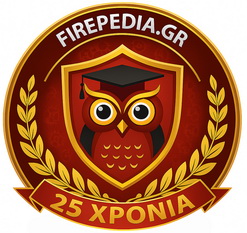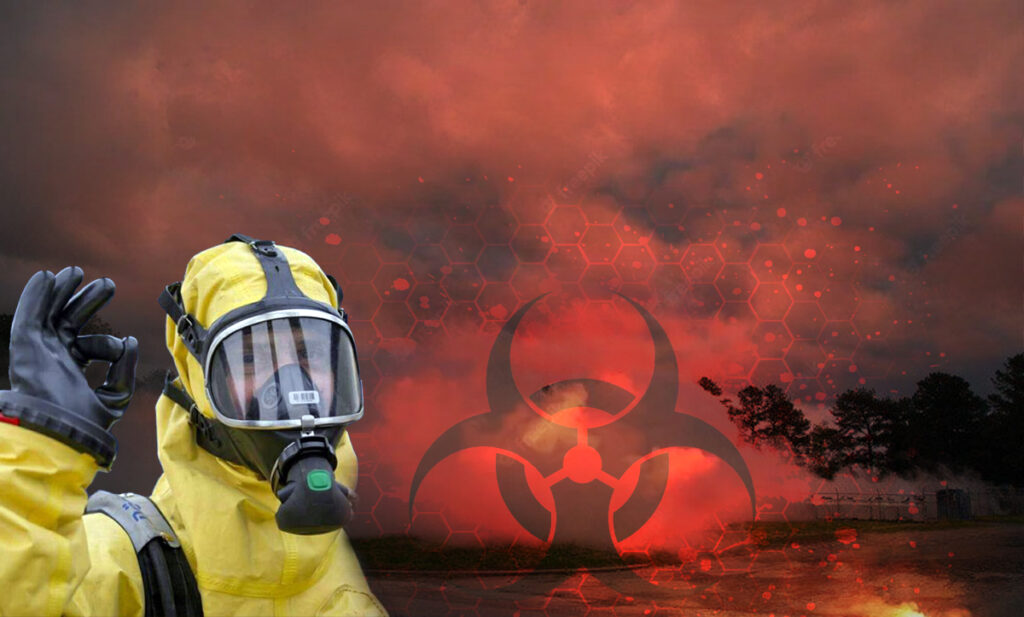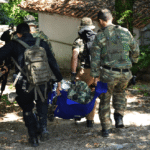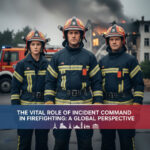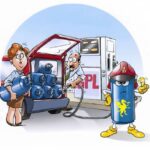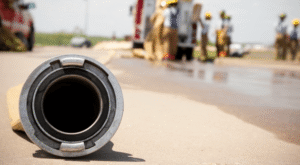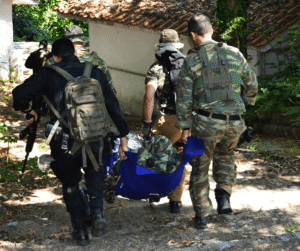The ability to communicate with rescuers, firefighters, or workers in refinery facilities has always been a headache for supervisors, safety technicians, and other personnel involved in emergency operations.
Every form of communication requires knowledge both of the equipment used (such as walkie-talkies) and of hand signals that allow non-verbal understanding. Looking back historically, we can see that in the fire department, the most common method of communication was through a micro-loudspeaker.
The user had to take a hand out of the sleeve of the chemical suit to grasp the transceiver’s microphone and communicate with the scene officer.
Communication Equipment in Chemical Suits
The use of portable transceivers inside chemical suits has been adopted by many services and tested over the years, revealing both good and bad practices as technology evolved.
Microspeakers, laryngophones, bone-conduction microphones, and even unique prototypes have been tested inside chemical suits, producing many stories that range from the amusing to the serious.
Today, several private and public services have purchased new-generation full-face masks equipped with integrated transceiver systems. These allow both intercom communication and external transmission via a PTT (Press-To-Talk) mechanism, ensuring safe and clear communication between users and scene officers.
All types of transceivers, old and new, whether VHF, UHF, PMR, DMR, or TETRA, can be integrated with these respirator systems to ensure maximum clarity and safety.
The Question of System Failure
But the crucial question remains: what happens if all these communication systems fail during a hazardous operation?
It is universally accepted that a chemical suit operator never works alone. Years of experience and countless incidents have proven that always sending rescuers in pairs is the safest solution.
The only exception is low-risk maintenance work in industrial settings, where the work permit explicitly allows a single operator.
Let’s imagine a scenario involving two firefighters wearing chemical suits in a chemical industry setting. They are called to manage a dangerous incident with unknown parameters. Communication, both between them and with the scene officer, is vital.
Even if they have intercom and radio equipment, various problems may arise.
Possible Causes of Communication Failure
Electromagnetic Pulse (EMP)
Let’s begin with the most unlikely but theoretically possible event—an electromagnetic pulse (EMP). Such a pulse could destroy or disable all electronic devices. While this is more relevant to defense systems and the side effects of nuclear explosions than to typical rescue operations, it serves as a useful example.
Malicious Actions
Malicious interference is a real risk, as experienced by security forces and fire services during various operations.
Malicious Actions | Signal Interference
An individual with the knowledge of a service’s frequency and undertones could intentionally jam transmissions, disrupting communication between rescuers, scene officers, and command centers. This is a criminal act but can still occur.
Malicious Actions | Signal Blocking Devices (Jammers)
Jammers are devices that emit synchronized radio waves at the same frequencies used by wireless systems, thereby blocking their operation.
They come in three main types:
- Portable devices: Small, low-power jammers (about the size of a mobile phone) that can block communication within 5–15 meters.
- Fixed units: Larger, more powerful systems that can disrupt multiple frequencies within 100 meters or more. They are usually installed in buildings and require constant power.
- Improvised devices: Custom-built, low-energy jammers made by individuals with specialized knowledge.
All these devices are illegal to possess or use.
Industrial Electromagnetic Fields
High-voltage power lines, transformers, and pylons can generate electromagnetic fields that interfere with communication equipment. Operators working near such installations may experience interruptions or degraded performance, depending on transceiver type and frequency.
Industrial Electromagnetic Fields | Corona Effect
The corona effect occurs when the electric field around high-voltage lines becomes strong enough to ionize the air, creating discharges along the surface of conductors. This can cause:
- Radio and TV interference
- Energy losses
- Audible crackling sounds
- Visible discharges at night
- Wave distortion
- Production of corrosive substances such as ozone and nitrogen oxides
Though rare, these effects can affect communication equipment near power lines.
Structural Interference
Incidents in tunnels or METRO stations present another challenge. While many facilities are designed to support radio frequencies, concrete, metal, and other construction materials can block signals or reduce range.
In such cases, operators may be required to use ATEX-certified transceivers or other specialized equipment, though even these can experience limitations. Some emergency teams, however, are equipped with internal relay systems that allow communication inside tunnels.
Hardware Failure
A hardware failure occurs when equipment does not perform as designed.
Examples include:
- Short battery life despite full charge indications
- Inability to transmit at the required distance
- Malfunctioning PTT buttons
- Improperly fitted or dropped earpieces
Note: ATEX transceivers typically have a maximum output power of 1W, which limits their range.
Equipment Damage
Equipment damage can occur during operations due to physical impacts or wear.
Examples include:
- Damaged antennas or amplifiers
- Malfunctioning transceiver circuits or intercom masks
- Battery leakage causing corrosion and current loss
These issues can lead to partial or total loss of communication during an operation.
The Need for Backup Communication: Hand Signals
Given all these potential failures, it is clear that the loss of radio communication inside a chemical suit is a realistic possibility. To address this, rescuers must have a reliable backup method.
Hand signals have long been used in safety, shipping, and industrial operations. However, specific hand signals designed for chemical suit operators are rarely documented in literature or online resources.
An exception is an older 2012 presentation by Yazid Bin Ismail, which proposed several gestures for hazard communication. Yet, a universally accepted, simple, and practical set of signals for chemical suit users did not exist—until recently.
Development of the Seven Hand Signals
In May 2022, a special CBRNE seminar was held at Draeger in Greece, attended by ten officers from the 1st and 2nd EMAK (HSDRU*) of the Fire Department.
During this seminar, we conducted a workshop on communication for chemical suit operators. Together, we developed and tested more than twenty possible hand signals.
Ultimately, we selected seven essential hand signals—simple, memorable, and sufficient for most emergency situations.
A short educational video was produced for training purposes. It is important to note that this video is unofficial and purely educational.
Neither the Fire Department nor Draeger, bears responsibility for any incorrect or unauthorized use of the signals or for any damages resulting from their misuse.
Analysis of the Seven Hand Signals
1. “Are You Okay?”
- Meaning: The operator asks a colleague or scene officer if everything is okay.
- Movement: Form a fist and tap the top of the head three times.
- Notes: The operator must look directly at the person being addressed. The same signal can be used as a reply.
2. “No Air”
- Meaning: The operator has lost air supply or is experiencing a breathing apparatus failure.
- Movement: With an open palm, move the hand horizontally across the neck area or below the eyes three times.
- Notes: Immediate assistance is required. Always maintain eye contact with the person being alerted.
3. “Danger in Area”
- Meaning: Indicates the presence of danger (e.g., chemicals, explosives).
- Movement: Raise both hands and cross them in front of the visor to form an “X.” Repeat the gesture three times with short pauses.
4. “Need to Exit Suit”
- Meaning: The operator must leave the suit immediately due to distress or malfunction (e.g., nausea, overheating, equipment failure).
- Movement: Make circular outward movements with both thumbs extended, indicating the need to remove the suit.
- Notes: Immediate intervention is necessary, as the operator may lose consciousness.
5. “Need Help”
- Meaning: Indicates that the operator requires assistance.
- Movement: Raise both hands above the head to form a “V” shape, repeating the gesture three times.
- Notes: This signal may indicate the need for support from additional personnel.
6. “Stretcher Needed”
- Meaning: A casualty has been found, and a stretcher is required.
- Movement: Mimic lifting a stretcher by moving both hands up and down as if holding its handles.
7. “Danger—Evacuate”
- Meaning: Immediate danger requiring evacuation of all personnel.
- Movement: Raise both arms outward and wave them repeatedly, similar to a “flying” motion, while approaching others quickly.
- Notes: This signal warns everyone in the hot zone to retreat immediately to the cold zone.
Summarizing all of the above, it becomes clear that losing communication during an incident while inside a chemical suit is a real possibility.
The seven hand signals described here provide a simple, effective, and universally understandable backup method for chemical suit operators to communicate vital information during emergencies.
I would like to thank the officers and firefighters of EMAK (HSDRU*) and the Fire Department for their cooperation, professionalism, and enthusiasm in developing this system.
Above all, I wish health, safety, and longevity for all members of the security forces who work daily under the most difficult conditions.
Si vis pacem, para bellum…
* (HSDRU) Hellenic Special Disaster Response Unit (Belongs to the Hellenic Fire Service)
| Article by John S. Retsios | |
 |
John S. Retsios is a health & safety consultant and personal protective equipment (PPE) trainer with more than 20 years of field experience. He specializes in equipment and response solutions for hazardous materials (HazMat) and CBRNe (Chemical, Biological, Radiological, Nuclear, and Explosive) emergencies, providing comprehensive expertise to organizations and professionals operating in demanding environments. » https://www.linkedin.com |
